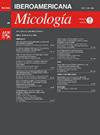异唑康唑的药代动力学新颖性。在特殊情况下使用。
IF 1.6
4区 生物学
Q4 MYCOLOGY
引用次数: 0
摘要
Isavuconazole是新一代三唑类药物,具有独特的药代动力学和药效学特性,是治疗危重患者和免疫功能低下患者侵袭性真菌感染的理想药物。这种抗真菌剂因其广泛的活性而脱颖而出,其中包括曲霉和毛霉菌等丝状真菌,其功效与伏立康唑相当,并且具有对抗这些病原体的额外优势。其高口服生物利用度(接近100%)、较长的半衰期(50 - 100小时)和线性、可预测的药代动力学特征,最大限度地减少了频繁剂量调整和治疗监测的需要。其亲脂性结构有助于渗透到关键组织,如中枢神经系统和肺组织,临床研究证实其在并发侵袭性真菌感染患者中的存活率超过70%。在肾功能损害、轻度至中度肝功能损害、儿科和肥胖人群中使用是安全的,但建议对严重肝功能损害进行剂量调整。最近对接受体外膜氧合或持续肾替代治疗的危重患者的研究显示,血药浓度中度降低,无显著临床影响。适应性给药策略已被提出以优化这些病例的疗效。与其他三唑类药物相比,异戊康唑具有较强的安全性,肝毒性和神经毒性发生率较低。其抗真菌活性,良好的药代动力学和良好的安全性强调了其作为抗真菌药物的参考作用,特别是在具有挑战性的临床情况下。本文章由计算机程序翻译,如有差异,请以英文原文为准。
Pharmacokinetic novelties of isavuconazole. Use in special situations
Isavuconazole, a next generation triazole, exhibits unique pharmacokinetic and pharmacodynamic properties that make it ideal for treating invasive fungal infections in critically ill and immunocompromised patients. This antifungal agent stands out for its broad spectrum of activity, which includes filamentous fungi such as Aspergillus and Mucorales, with an efficacy comparable to that of voriconazole and additional advantages against these pathogens. Its high oral bioavailability (close to 100%), prolonged half-life (>100 h), and linear, predictable pharmacokinetic profile minimize the need for frequent dose adjustments and therapeutic monitoring. Its lipophilic structure facilitates penetration into key tissues, such as the central nervous system and pulmonary tissue, as validated by clinical studies showing survival rates exceeding 70% in patients with complicated invasive fungal infection. Its use is safe in populations with renal impairment, mild to moderate hepatic impairment, paediatrics, and obesity, although dose adjustment is recommended for severe hepatic impairment. Recent studies in critically ill patients undergoing extracorporeal membrane oxygenation or continuous renal replacement therapy have revealed moderate reductions in plasma concentration, without significant clinical impact. Adaptive dosing strategies have been proposed to optimize efficacy in these cases. Compared to other triazoles, isavuconazole demonstrates a robust safety profile, with lower incidences of hepatotoxicity and neurotoxicity. Its antifungal activity, favorable pharmacokinetics, and excellent safety profile underscore its role as a reference antifungal agent, particularly in challenging clinical scenarios.
求助全文
通过发布文献求助,成功后即可免费获取论文全文。
去求助
来源期刊

Revista Iberoamericana De Micologia
MYCOLOGY-
CiteScore
1.90
自引率
0.00%
发文量
17
审稿时长
81 days
期刊介绍:
Revista Iberoamericana de Micología (Ibero-American Journal of Mycology) is the official journal of the Asociación Española de Micología, Asociación Venezolana de Micología and Asociación Argentina de Micología (The Spanish, Venezuelan, and Argentinian Mycology Associations). The Journal gives priority to publishing articles on studies associated with fungi and their pathogenic action on humans and animals, as well as any scientific studies on any aspect of mycology. The Journal also publishes, in Spanish and in English, original articles, reviews, mycology forums, editorials, special articles, notes, and letters to the editor, that have previously gone through a scientific peer review process.
 求助内容:
求助内容: 应助结果提醒方式:
应助结果提醒方式:


